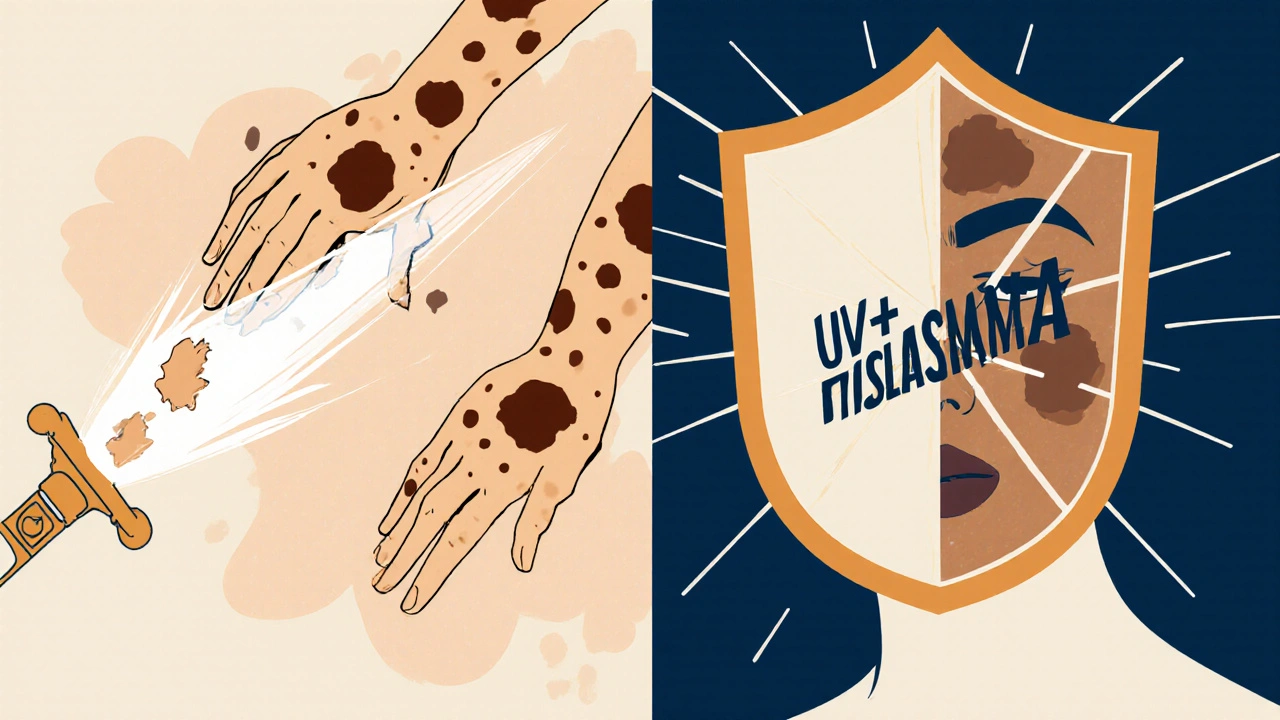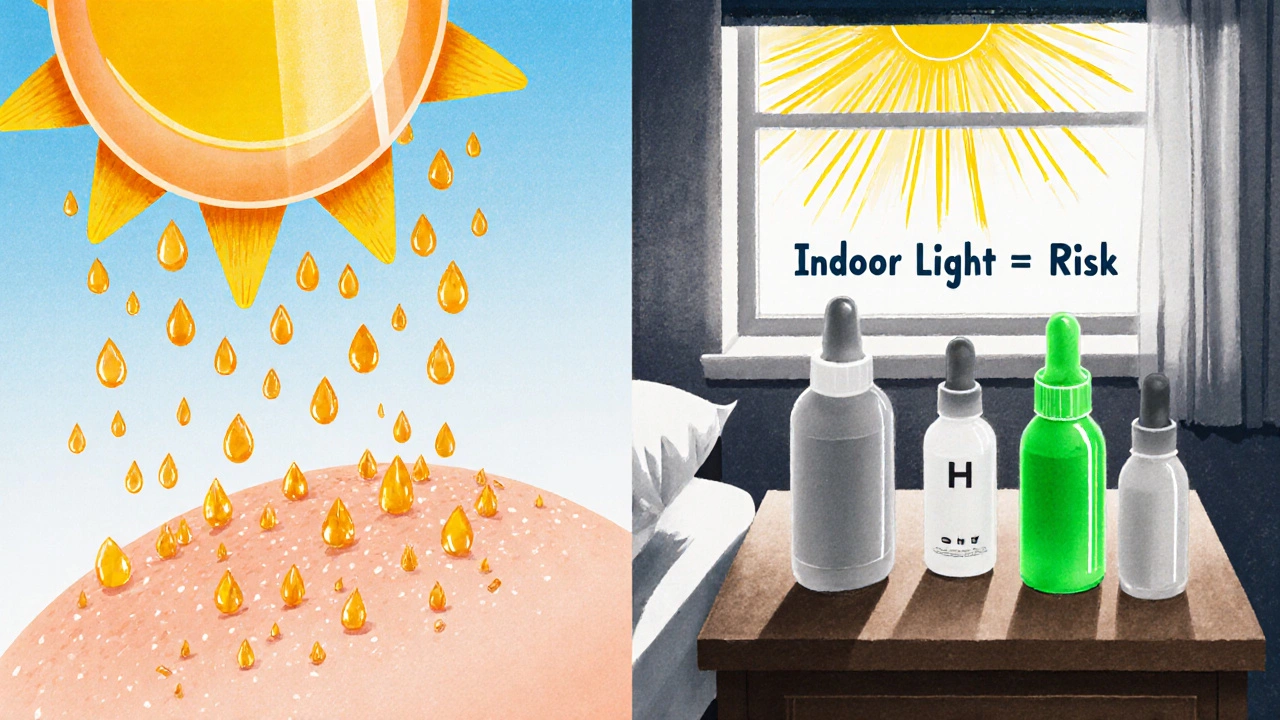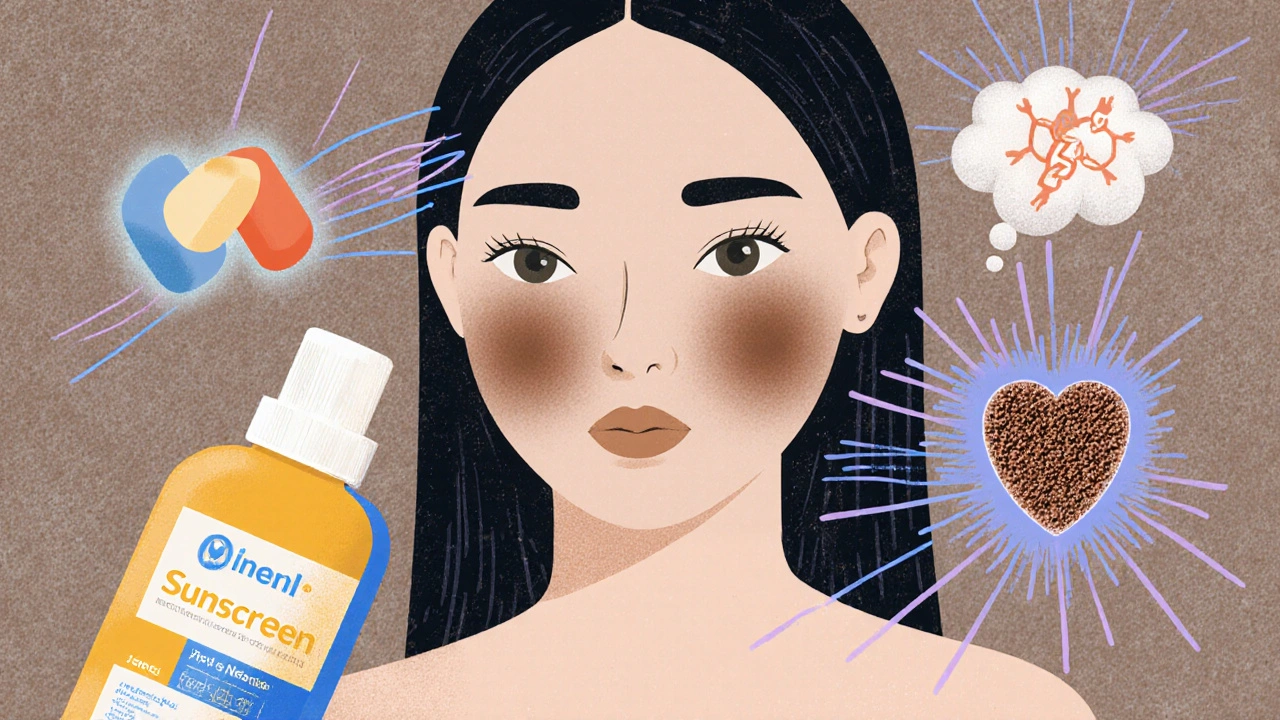What Is Hyperpigmentation, Really?
Hyperpigmentation isn’t just a tan that won’t fade. It’s darker patches on your skin caused by too much melanin - the pigment that gives skin its color. Two of the most common forms are melasma and sun damage (solar lentigines). They look similar, but they’re not the same. Mixing them up can lead to the wrong treatment - and make things worse.
Think of melasma as a hormonal storm hitting your skin. It shows up as big, blurry patches on your cheeks, forehead, or upper lip. It mostly affects women, especially those with medium to dark skin tones. Sun damage, on the other hand, is slower and more predictable. It shows up as small, defined spots on your face, hands, or shoulders - the places you’ve spent years in the sun. These are the spots people call "age spots" or "liver spots," but they’re not about aging. They’re about exposure.
Melasma: More Than Just a Tan
Melasma doesn’t just come from the sun. Yes, UV rays play a role, but so do hormones, visible light, and even heat. That’s why it’s so common during pregnancy (sometimes called the "mask of pregnancy") or in women taking birth control pills. Studies show that hormonal triggers are behind 60-70% of cases in women of reproductive age.
What makes melasma tricky is how sensitive it is to light. Regular sunscreens that only block UV rays aren’t enough. Visible light - the kind that comes through windows and screens - can trigger melanin production too. That’s why dermatologists now recommend mineral sunscreens with iron oxides. These block visible light and reduce melasma flare-ups by up to 30%.
And here’s the hard truth: melasma doesn’t go away easily. Even with treatment, over 80% of people see it come back within a year if they stop protecting their skin. That’s why long-term management, not quick fixes, is the goal.
Sun Damage: The Quiet Accumulator
Solar lentigines - the technical name for sun spots - are the result of years of UV exposure. Every time your skin gets sunburned or even just tanned, melanocytes get activated. Over time, they cluster together and produce too much pigment in one spot. By age 60, about 90% of fair-skinned people have them.
Unlike melasma, sun damage responds well to treatment. A single IPL (intense pulsed light) session can darken the spots, which then flake off in 3-5 days. Most people see 75-90% improvement after 1-3 sessions. But here’s the catch: if you keep exposing your skin to the sun after treatment, the spots will come back - sometimes faster than before.
And don’t be fooled by the name. These aren’t just for older people. Someone in their 30s who spent summers at the beach without sunscreen can have the same spots as someone in their 60s. Prevention is cheaper, easier, and more effective than correction.

Topical Agents That Actually Work
Not all creams are created equal. Here’s what dermatologists actually prescribe - and why.
- Hydroquinone (4%): This is the gold standard for fading dark spots. It blocks the enzyme that makes melanin. Used alone, it helps about half of melasma cases. But when combined with tretinoin and a corticosteroid (a triple combo), effectiveness jumps to 50-70% in 12 weeks. The catch? Use it longer than 3 months, and you risk exogenous ochronosis - a rare but permanent brownish discoloration.
- Tretinoin (0.025-0.1%): This retinoid speeds up skin cell turnover. It doesn’t lighten pigment directly, but it helps flush it out faster. It also makes other treatments like hydroquinone work better. Start slow - once every other night - to avoid redness and peeling.
- Vitamin C (10-20% L-ascorbic acid): A powerful antioxidant that neutralizes free radicals from UV exposure and light. It also inhibits tyrosinase, the same enzyme hydroquinone targets. It’s gentler than hydroquinone and safe for long-term use. Use it in the morning under sunscreen.
- Tranexamic acid (5%): Originally a blood-clotting drug, it’s now used topically for melasma. Studies show it reduces pigmentation by 45% in 12 weeks with almost no side effects. It’s especially helpful for people who can’t use hydroquinone.
- Niacinamide (4-5%): A form of vitamin B3 that reduces melanin transfer to skin cells. It’s mild, hydrating, and great for sensitive skin. Works well with other ingredients.
Most dermatologists now recommend a morning routine of vitamin C + iron oxide sunscreen, and an evening routine of alternating tretinoin and hydroquinone. Don’t use both on the same night - it’s too harsh. Start with every third night and build up over 4-6 weeks.
Why Lasers Can Make Melasma Worse
Laser and light treatments like IPL, fractional lasers, and Q-switched lasers work great for sun damage. But for melasma? They’re risky.
These treatments use heat to break up pigment. Melasma skin is already overstimulated. Heat can trigger even more melanin production, making patches darker and more widespread. Studies show IPL worsens melasma in 30-40% of cases.
Dermatologists only consider lasers for melasma after 8-12 weeks of topical treatment have calmed down the melanocytes. Even then, they use low-energy settings and avoid heat-based devices. Some newer lasers, like the 1064nm Nd:YAG, are safer - but only if used by an experienced provider.

What You’re Probably Doing Wrong
Most people fail not because the treatments don’t work - but because they don’t stick with them.
- Skipping sunscreen: 70% of patients use less than half the amount needed. You need about a quarter-teaspoon for your face - and you must reapply every 2 hours if you’re outside.
- Using sunscreen only outdoors: UV and visible light come through windows. You need SPF 50+ every day, even if you’re working from home.
- Expecting overnight results: Topical treatments take 8-12 weeks to show visible changes. Quitting early means you’ll never know if it could have worked.
- Trying OTC products first: 85% of melasma patients start with drugstore creams. Most contain low-dose ingredients that won’t move the needle. By the time they see a dermatologist, the condition is worse.
What’s Next: New Treatments on the Horizon
The hyperpigmentation market is growing fast - worth over $12 billion in 2022 - and new options are coming.
- Cysteamine cream (10%): A non-hydroquinone option that showed 60% improvement in melasma after 16 weeks in clinical trials, with minimal irritation.
- Tranexamic acid pills: Oral doses are being studied for stubborn melasma. Early results look promising, but long-term safety is still under review.
- Personalized treatment: Dermatologists are starting to use genetic markers to predict who will respond to which treatment. Within five years, your skin type and DNA could guide your cream choices.
But the biggest breakthrough isn’t a new drug - it’s better patient education. Studies show only 35% of people use their prescriptions consistently. Simplifying routines - like combining two steps into one product - could make all the difference.
The Bottom Line
Melasma and sun damage need different strategies. Sun damage responds quickly to lasers and strong topicals. Melasma needs patience, protection, and a multi-step approach. The most important thing you can do? Protect your skin - every single day.
Use mineral sunscreen with iron oxides. Apply it like you mean it. Stick with your routine for at least three months. And don’t rush into lasers unless your dermatologist says it’s safe. Hyperpigmentation isn’t a flaw to be erased. It’s a signal - and if you listen, your skin will thank you.
Can melasma go away on its own?
Yes, but only in some cases. Melasma that develops during pregnancy often fades within a few months after delivery. For others, it rarely disappears without treatment. Even when it does fade, it can return with sun exposure or hormonal changes. Long-term management is usually needed.
Is hydroquinone safe for long-term use?
No. Hydroquinone is typically limited to 3-4 months at a time because of the risk of exogenous ochronosis - a rare but permanent blue-black discoloration. After that, switch to alternatives like tranexamic acid, niacinamide, or vitamin C. Always use it under a dermatologist’s guidance.
Why do I need sunscreen even indoors?
UVA rays and visible light can penetrate windows and screens. Visible light, in particular, triggers melanin production in melasma-prone skin. Studies show that up to 30% of melasma cases are worsened by indoor light exposure. Daily sunscreen is non-negotiable - whether you’re at home, in the car, or at your desk.
Can men get melasma?
Yes, but it’s much less common. Only about 10% of melasma cases occur in men. When it does, it’s often linked to hormonal imbalances, certain medications, or heavy sun exposure. The same treatments apply, but men tend to respond better to topical therapy because they’re less likely to have hormonal triggers.
What’s the difference between melasma and post-inflammatory hyperpigmentation (PIH)?
Melasma appears symmetrically on sun-exposed areas like cheeks and forehead, often linked to hormones. PIH happens after skin injury - like acne, cuts, or burns - and shows up where the inflammation occurred, regardless of sun exposure. PIH is more common in darker skin tones and can worsen with laser treatments, so diagnosis matters.
How long does it take to see results from topical treatments?
Most people start noticing subtle lightening after 6-8 weeks. Clear results usually appear between 12 and 16 weeks. If you don’t see any change by 3 months, your regimen may need adjustment. Don’t quit early - consistency is what makes the difference.
Are natural remedies like lemon juice or aloe vera effective?
No. Lemon juice is highly acidic and can burn your skin, making pigmentation worse. Aloe vera is soothing but doesn’t affect melanin production. Natural doesn’t mean effective - and sometimes it’s dangerous. Stick to ingredients backed by clinical studies: hydroquinone, tretinoin, vitamin C, tranexamic acid, and niacinamide.
Can I use these treatments if I have sensitive skin?
Yes, but start slowly. Use lower concentrations - like 0.025% tretinoin or 5% niacinamide. Introduce one product at a time, every other night. Skip hydroquinone if you’re prone to irritation. Focus on sunscreen, vitamin C, and gentle moisturizers first. Patch test everything before applying to your whole face.


Comments
Scott Macfadyen
So let me get this straight - I’ve been slathering on SPF 50 every morning like it’s holy water, but apparently I’m still getting wrecked by my laptop screen? That’s wild. I thought the only thing killing my skin was my 3 a.m. TikTok binges. Guess I need to buy a monitor filter now too.
November 18, 2025 AT 17:07
Chloe Sevigny
The ontological implications of melasma as a socio-hormonal epidermal phenomenon are profoundly under-discussed in dermatological discourse. One must interrogate the neoliberal commodification of skin ‘perfection’ - wherein hyperpigmentation is pathologized not as a biological variable, but as a marketable defect requiring pharmaceutical remediation. The iron oxide sunscreen industry, in this light, is less a medical intervention than a performative ritual of bodily compliance.
November 19, 2025 AT 20:04
Denise Cauchon
Canada’s got the best sunscreen laws, honestly. We don’t let these toxic hydroquinone creams fly off the shelves like they do in the US. You think you’re fixing your skin, but you’re just signing up for blue-black ghost face later. I’ve seen it. My cousin’s aunt’s neighbor? Permanent discoloration. No thanks. Stick to niacinamide and pray to the sun gods.
November 21, 2025 AT 04:52
Andrea Johnston
Oh sweet merciful heavens, another person who thinks ‘natural remedies’ are a thing. Lemon juice? You’re not treating melasma - you’re doing a chemical peel on your face with citrus rinds. That’s not wellness, that’s self-sabotage with a side of existential dread. If your skincare routine looks like a Pinterest board from 2013, you’re doing it wrong.
November 21, 2025 AT 16:07
Victoria Malloy
I’ve been using vitamin C + niacinamide for 4 months now and honestly? My skin looks calmer. Not perfect, but better. It’s not about erasing every spot - it’s about feeling okay in your own skin. Keep going. You’re doing better than you think.
November 23, 2025 AT 06:46
Alex Czartoryski
Laser for melasma? Bro. I got IPL last year thinking I’d look like a Disney prince. Instead I looked like a burnt marshmallow with a side of regret. Now I’m stuck with darker patches and a $2k bill. Don’t be me. Just wear the damn sunscreen. And maybe cry a little.
November 23, 2025 AT 11:35
Gizela Cardoso
My dermatologist said to use tretinoin every third night and I thought she was joking. Turned out she was being kind. First week? My face looked like a red angry taco. But after 6 weeks? The spots are fading. It’s not magic - it’s just patience. And a lot of moisturizer.
November 23, 2025 AT 12:04
Emily Entwistle
OMG YES to the iron oxide sunscreen!! I switched to Beautycounter’s and my melasma finally stopped screaming at me 😭☀️ I used to think sunscreen was just for beach days - now I wear it like a second skin. Even at my desk. Even in pajamas. I’m a convert.
November 24, 2025 AT 05:08
Duncan Prowel
Could you clarify the mechanism by which visible light induces melanogenesis in melasma-prone skin? The referenced studies appear to implicate melanopsin activation in dermal melanocytes, yet the spectral range of 400–700 nm is not traditionally considered phototoxic. Is there evidence for non-UV-mediated tyrosinase upregulation independent of heat shock proteins?
November 24, 2025 AT 09:32
Bruce Bain
Man, I never knew my grandma’s spots were from the sun and not just ‘getting old.’ She used to say, ‘Son, that’s just life.’ Turns out she was right - just for the wrong reasons. I’m starting to wear sunscreen now. Even when I mow the lawn. She’d be proud.
November 25, 2025 AT 07:01
Jonathan Gabriel
So let me get this straight - you’re telling me that my $80 vitamin C serum from Sephora is legit… but my $12 aloe gel from Target is ‘dangerous’? What even is this world? I’ve been using lemon juice since college and my skin still looks better than my ex’s. Also, hydroquinone is basically bleach - why is this even legal?
November 26, 2025 AT 00:08
Don Angel
Okay, but what about the fact that most of these studies are funded by big pharma? And that ‘clinical trials’ often exclude people with darker skin tones? And that the ‘gold standard’ treatment is literally a chemical that’s banned in Europe? I’m not saying it’s a conspiracy… but I’m also not not saying it’s a conspiracy.
November 27, 2025 AT 15:09
benedict nwokedi
They don’t want you to know this - but melasma is caused by EMF radiation from 5G towers, WiFi routers, and your smart fridge. The ‘iron oxide’ in sunscreen? It’s a placebo. Real protection? Faraday cage face masks. I wear mine every day. My skin is flawless. The FDA doesn’t want you to know this. They’re in bed with Big Sunscreen.
November 28, 2025 AT 17:39
deepak kumar
Bro, I'm from India, melasma is everywhere here. My mom used turmeric paste, I used hydroquinone, now I use tranexamic acid. The real game-changer? Sunscreen. Not the fancy one - the one you reapply. Even when you're inside. Even when you're angry. Even when you're late. Skin doesn't care about your schedule.
November 29, 2025 AT 17:34